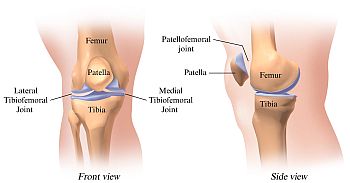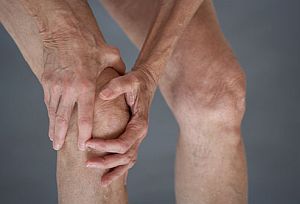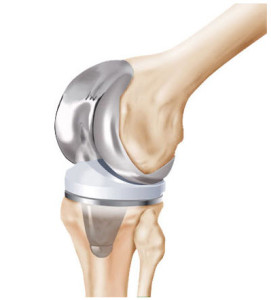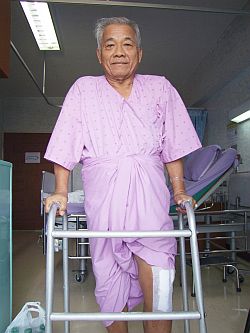Set an end to knee pain and immobility!
What is osteoarthritis, and why does my knee hurt?

In the knee joint, there is a layer of smooth cartilage on the lower end of the femur (thigh bone), the upper end of the tibia (shin bone), and the under-surface of the kneecap (patella). This cartilage serves as a cushion and allows for smooth motion of the knee. Osteoarthritis is caused by wearing away of this smooth cartilage. Eventually, it wears down to bone. Rubbing of bone against bone causes discomfort, swelling, stiffness and pain.
What causes osteoarthritis?
Age is a significant factor in the decreasing ability of the cartilage to heal. Research has shown that women are more likely to develop osteoartritis of the knee than men. Obesity can certainly be a major factor: having to carry too much extra weight puts a strain on knee joints, making the cartilage wear out much quicker than it normally would. Certain occupations that contain stressful activity on the knee joint, such as kneeling and squatting can be a factor as well, Finally, if you've ever had an knee injury, especially torn knee cartilage that required surgery, you could be more prone to getting knee replacement.
What are the symptoms?

Pain is the primary, classic symptom. It can make your knee feel sore and achy. Knee pain can become more intense when you move your knee, such as when you sit down or walk, and it may become more noticeable after prolonged use. You may also notice a creaking, crackly sound when exercising your knee. Swelling and stiffness are other common symptoms; they can make your knee joint feel difficult to bend or straighten. Your knee may also "lock up", preventing you from easily bending or straightening it. If any of these symptoms persist, it may be time to
schedule an appointment (link opens in a new window) with one of our specialists, to assess the status and health of your knee.
What is a total knee replacement?

A total knee replacement is really a bone and cartilage replacement with an artificial surface. The knee itself is not replaced, as is commonly thought, but rather an artificial substitute for the cartilage, or implant, is inserted on the end of the bones. This is done with a metal implant on the femur/tibia and a plastic spacer in between and under the kneecap. This creates a new, smooth cushion and a functioning joint that does not hurt.
What results can you expect?

Results will vary depending on the quality of the surrounding tissue, the severity of the arthritis at the time of surgery, your activity level and – not entirely unimportant either – on your adherence to doctor's orders for rehabilitation after the surgery.
In general, 90-95% of patients achieve good to excellent results, with relief of pain and discomfort, and significantly increased activity and mobility. Age is not a problem if you are in reasonable health and have the desire to continue living an active and productive life.
All implants have a limited life expectancy, largely depending on a person's age, weight, activity level and general medical condition. A total joint implant is a mechanical device subject to wear that can lead to mechanical failure. Its longevity will vary in every patient. It is therefore also very important to follow the advice given by our orthopedic specialists.
The process and the team.
Choosing to have knee replacement surgery is a long process, that already began when you first started feeling pain and immobility, and comes to a conclusion after consulting with our specialists, who use state-of-the-art technology to "look into" your knee and assess the status and need for surgery. There are three phases involved: pre-operative, operative and recovery, each with its own specialized team. And you're always the team member at the center! From the day you check in at our hospital to discharge, you have to reckon with a 7-days (6 nights) stay.
The pre-operative phase starts on the day after you check in, and consists of knee assessment by an orthopedic physician, followed by extensive laboratory and medical tests to ascertain every safety aspect of an upcoming surgery. If all test results say "go", surgery is scheduled on the 3rd day, followed by three days of rehabilitation. Already a short time after you return to the hospital floor from surgery, our nursing staff will assist you in walking. Physical therapy will begin the next morning, and you will already be walking with a walker later that day.
Search within the website:


 In the knee joint, there is a layer of smooth cartilage on the lower end of the femur (thigh bone), the upper end of the tibia (shin bone), and the under-surface of the kneecap (patella). This cartilage serves as a cushion and allows for smooth motion of the knee. Osteoarthritis is caused by wearing away of this smooth cartilage. Eventually, it wears down to bone. Rubbing of bone against bone causes discomfort, swelling, stiffness and pain.
In the knee joint, there is a layer of smooth cartilage on the lower end of the femur (thigh bone), the upper end of the tibia (shin bone), and the under-surface of the kneecap (patella). This cartilage serves as a cushion and allows for smooth motion of the knee. Osteoarthritis is caused by wearing away of this smooth cartilage. Eventually, it wears down to bone. Rubbing of bone against bone causes discomfort, swelling, stiffness and pain. Pain is the primary, classic symptom. It can make your knee feel sore and achy. Knee pain can become more intense when you move your knee, such as when you sit down or walk, and it may become more noticeable after prolonged use. You may also notice a creaking, crackly sound when exercising your knee. Swelling and stiffness are other common symptoms; they can make your knee joint feel difficult to bend or straighten. Your knee may also "lock up", preventing you from easily bending or straightening it. If any of these symptoms persist, it may be time to schedule an appointment (link opens in a new window) with one of our specialists, to assess the status and health of your knee.
Pain is the primary, classic symptom. It can make your knee feel sore and achy. Knee pain can become more intense when you move your knee, such as when you sit down or walk, and it may become more noticeable after prolonged use. You may also notice a creaking, crackly sound when exercising your knee. Swelling and stiffness are other common symptoms; they can make your knee joint feel difficult to bend or straighten. Your knee may also "lock up", preventing you from easily bending or straightening it. If any of these symptoms persist, it may be time to schedule an appointment (link opens in a new window) with one of our specialists, to assess the status and health of your knee. A total knee replacement is really a bone and cartilage replacement with an artificial surface. The knee itself is not replaced, as is commonly thought, but rather an artificial substitute for the cartilage, or implant, is inserted on the end of the bones. This is done with a metal implant on the femur/tibia and a plastic spacer in between and under the kneecap. This creates a new, smooth cushion and a functioning joint that does not hurt.
A total knee replacement is really a bone and cartilage replacement with an artificial surface. The knee itself is not replaced, as is commonly thought, but rather an artificial substitute for the cartilage, or implant, is inserted on the end of the bones. This is done with a metal implant on the femur/tibia and a plastic spacer in between and under the kneecap. This creates a new, smooth cushion and a functioning joint that does not hurt. Results will vary depending on the quality of the surrounding tissue, the severity of the arthritis at the time of surgery, your activity level and – not entirely unimportant either – on your adherence to doctor's orders for rehabilitation after the surgery.
Results will vary depending on the quality of the surrounding tissue, the severity of the arthritis at the time of surgery, your activity level and – not entirely unimportant either – on your adherence to doctor's orders for rehabilitation after the surgery.